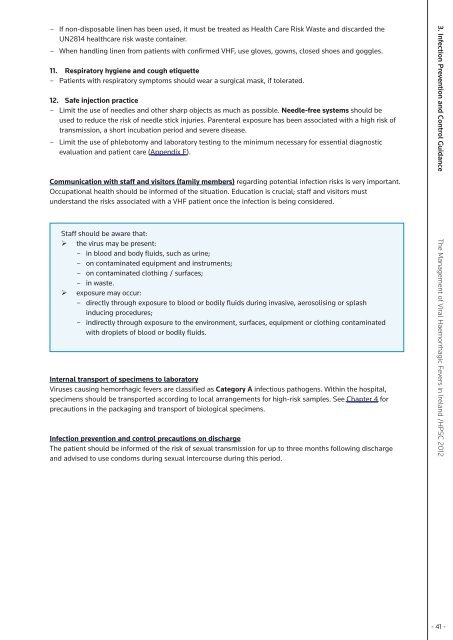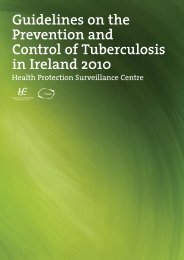The Management of Viral Haemorrhagic Fevers in Ireland - Health ...
The Management of Viral Haemorrhagic Fevers in Ireland - Health ...
The Management of Viral Haemorrhagic Fevers in Ireland - Health ...
Create successful ePaper yourself
Turn your PDF publications into a flip-book with our unique Google optimized e-Paper software.
- If non-disposable l<strong>in</strong>en has been used, it must be treated as <strong>Health</strong> Care Risk Waste and discarded theUN2814 healthcare risk waste conta<strong>in</strong>er.- When handl<strong>in</strong>g l<strong>in</strong>en from patients with confirmed VHF, use gloves, gowns, closed shoes and goggles.11. Respiratory hygiene and cough etiquette- Patients with respiratory symptoms should wear a surgical mask, if tolerated.12. Safe <strong>in</strong>jection practice- Limit the use <strong>of</strong> needles and other sharp objects as much as possible. Needle-free systems should beused to reduce the risk <strong>of</strong> needle stick <strong>in</strong>juries. Parenteral exposure has been associated with a high risk <strong>of</strong>transmission, a short <strong>in</strong>cubation period and severe disease.- Limit the use <strong>of</strong> phlebotomy and laboratory test<strong>in</strong>g to the m<strong>in</strong>imum necessary for essential diagnosticevaluation and patient care (Appendix F).Communication with staff and visitors (family members) regard<strong>in</strong>g potential <strong>in</strong>fection risks is very important.Occupational health should be <strong>in</strong>formed <strong>of</strong> the situation. Education is crucial; staff and visitors mustunderstand the risks associated with a VHF patient once the <strong>in</strong>fection is be<strong>in</strong>g considered.Staff should be aware that:‣ the virus may be present:- <strong>in</strong> blood and body fluids, such as ur<strong>in</strong>e;- on contam<strong>in</strong>ated equipment and <strong>in</strong>struments;- on contam<strong>in</strong>ated cloth<strong>in</strong>g / surfaces;- <strong>in</strong> waste.‣ exposure may occur:- directly through exposure to blood or bodily fluids dur<strong>in</strong>g <strong>in</strong>vasive, aerosolis<strong>in</strong>g or splash<strong>in</strong>duc<strong>in</strong>g procedures;- <strong>in</strong>directly through exposure to the environment, surfaces, equipment or cloth<strong>in</strong>g contam<strong>in</strong>atedwith droplets <strong>of</strong> blood or bodily fluids.Internal transport <strong>of</strong> specimens to laboratoryViruses caus<strong>in</strong>g hemorrhagic fevers are classified as Category A <strong>in</strong>fectious pathogens. With<strong>in</strong> the hospital,specimens should be transported accord<strong>in</strong>g to local arrangements for high-risk samples. See Chapter 4 forprecautions <strong>in</strong> the packag<strong>in</strong>g and transport <strong>of</strong> biological specimens.Infection prevention and control precautions on discharge<strong>The</strong> patient should be <strong>in</strong>formed <strong>of</strong> the risk <strong>of</strong> sexual transmission for up to three months follow<strong>in</strong>g dischargeand advised to use condoms dur<strong>in</strong>g sexual <strong>in</strong>tercourse dur<strong>in</strong>g this period.3. Infection Prevention and Control Guidance <strong>The</strong> <strong>Management</strong> <strong>of</strong> <strong>Viral</strong> <strong>Haemorrhagic</strong> <strong>Fevers</strong> <strong>in</strong> <strong>Ireland</strong> /HPSC 2012- 41 -
















